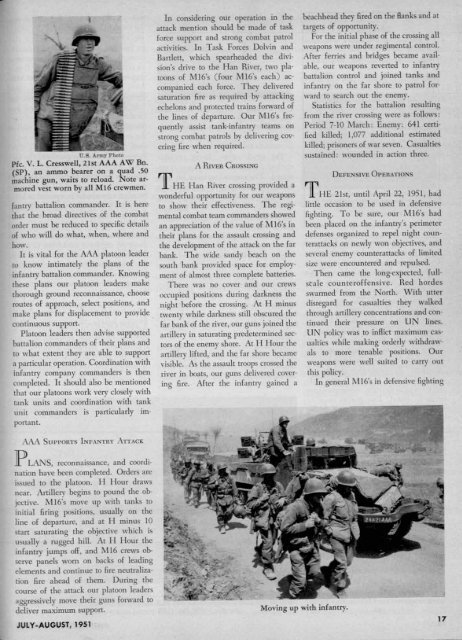July-August - Air Defense Artillery
July-August - Air Defense Artillery
July-August - Air Defense Artillery
You also want an ePaper? Increase the reach of your titles
YUMPU automatically turns print PDFs into web optimized ePapers that Google loves.
U.S. Army Photo<br />
Pfc. V. L. Cresswell, 21st AAA AWl Bn.<br />
(SP), an ammo bearer on a quad .50<br />
machine gun, waits to reload. Note armored<br />
vest worn by alll\1I6 crewmen.<br />
fan try battalion commander. It is here<br />
that the broad directives of the combat<br />
order must be reduced to specific details<br />
of who will do what, when, where and<br />
how.<br />
It is vital for the 1\1\1\ platoon leader<br />
to know intimately the plans of the<br />
infantry battalion commander. Knowing<br />
these plans our platoon leaders make<br />
thorough ground reconnaissance, choose<br />
routes of approach, .select positions, and<br />
make plans for displacement to provide<br />
continuous support.<br />
Platoon leaders then advise supported<br />
battalion commanders of their plans and<br />
to what extent they are able to support<br />
a particular operation. Coordination with<br />
infantry company commanders is then<br />
completed. It should also be mentioned<br />
that our platoons work very closely with<br />
tank units and coordination with tank<br />
unit commanders is particularly important.<br />
AAA SUPPORTS INFANTRY ATTACK<br />
JPL1\NS, reconnaissance, and coordination<br />
have been completed. Orders are<br />
issued to the platoon. H I-lour draws<br />
near. <strong>Artillery</strong> begins to pound the objective.<br />
M 16's move up with tanks to<br />
initial firing positions, usually on the<br />
line of departure, and at H minus 10<br />
start saturating the objective which is<br />
usually a rugged hill. At H Hour the<br />
infantry jumps off, and 1\116 crews observe<br />
panels worn on backs of leading<br />
elements and continue to fire neutralization<br />
fire ahead of them. During the<br />
course of the attack our platoon leaders<br />
aggressively move their guns forward to<br />
deliver maximum support.<br />
JULY-AUGUST, 1951<br />
In considering our operation in the<br />
attack mention should be made of task<br />
force support and strong combat patrol<br />
acti,'ities. In Task Forces Doh-in and<br />
Bartlett, which spearheaded the division's<br />
drive to the Han River, two platoons<br />
of 1\116's (four 1\116's each) accompanied<br />
each force. They delivered<br />
saturation fire as required by attacking<br />
echelons and protected trains forward of<br />
the lines of departure. Our 1\116's frequently<br />
assist tank-infantry teams on<br />
strong combat patrols by deli,'ering covering<br />
fire ,,:hen required.<br />
A RIVER CROSSING<br />
T HE I-Ian River crossing provided a<br />
wonderful opportunity for our weapons<br />
to show their effectiveness. The regimental<br />
combat team commanders showed<br />
an appreciation of the value of M16's in<br />
their plans for the assault crossing and<br />
the development of the attack on the far<br />
bank. The wide sandy beach on the<br />
south bank provided space for employment<br />
of almost three complete batteries.<br />
There was no cover and our crews<br />
occupied positions during darkness the<br />
night before the crossing. At H minus<br />
twenty while darkness still obscured the<br />
far bank of the river, our guns joined the<br />
artillery in saturating predetermined sectors<br />
of the enemy shore. At H I-lour the<br />
artillery lifted, and the far shore became<br />
visible. As the assault troops crossed the<br />
river in boats, our guns delivered covering<br />
fire. After the infantry gained a<br />
beachhead they fired on the Hanks and at<br />
targets of opportunity.<br />
For the initial phase of the crossing all<br />
weapons were under regimental control.<br />
After ferries and bridges became a,'ailable,<br />
our weapons reverted to infantry<br />
battalion control and joined tanks and<br />
infantry on the far shore to patrol forward<br />
to search out the enemy.<br />
Statistics for the battalion resulting<br />
from the river crossing were as follows:<br />
Period 7-10 1\larch: Enemy: 641 certified<br />
killed; 1,077 additional estimated<br />
killed; prisoners of war seven. Casualties<br />
sustained: wounded in action three.<br />
Moving up with infantry.<br />
DEFENSIVE OPERATIONS<br />
THE 21st, until April 22, 1951, had<br />
little occasion to be used in defensive<br />
fighting. To be sure, our M 16's had<br />
been placed on the infantry's perimeter<br />
defenses organized to repel night counterattacks<br />
on newly won objectives, and<br />
several enemy counterattacks of limited<br />
size were encountered and repulsed.<br />
Then came the long-expected, fullstale<br />
counteroffensive. Red hordes<br />
swarmed from the North. \Vith utter<br />
disregard for casualties they walked<br />
through artillery concentrations and continued<br />
their pressure on UN lines.<br />
UN policy was to inflict maximum casualties<br />
while making orderly withdrawals<br />
to more tenable positions. Our<br />
weapons were well suited to carry out<br />
this policy.<br />
In general 1'\'116'5in defensive fighting<br />
17
















